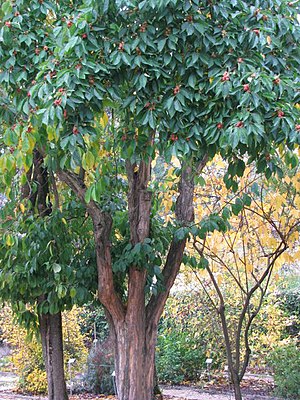Silkworm tree
| Silkworm tree | ||||||||||||
|---|---|---|---|---|---|---|---|---|---|---|---|---|

Silkworm tree ( Maclura tricuspidata ) |
||||||||||||
| Systematics | ||||||||||||
|
||||||||||||
| Scientific name | ||||||||||||
| Maclura tricuspidata | ||||||||||||
| ( Carrière ) Bureau |
The silkworm tree ( Maclura tricuspidata ), also Che called, is a plant of the genus of Maclura in the family of the Mulberry family (Moraceae).
description
The silkworm tree grows as a deciduous shrub or small tree that reaches heights of 1 to about 7 meters or a little more. The bark is grayish-brown and flakes off. Young plants and root shoots in particular are thorny, while the upper branches of older trees also grow thornless. The thorns have a length of 0.5 to 2 centimeters. The buds are reddish-brown.
The alternate and spirally arranged leaves are stalked 1 to 2 centimeters long. The petiole is slightly hairy. The leaf shape is variable, normally it is ovate to obovate or elliptical, in young plants three-lobed, later unlobed leaves appear, similar to the related mulberries . The leaf blade has a size of 5 to 14 × 3 to 6 centimeters, it is glabrous on top and slightly hairy on the underside. The leaf margin is whole, the tip is rounded, round-pointed to pointed or pointed. The stipules are not fused.
The flowering time is late, even after mulberry trees, from May to June. The silkworm tree is said to be essentially dioecious, separate sexes ( diocesan ), but male flowers also occur sporadically on female plants or on whole branches and vice versa. The stalked and capid inflorescences stand individually or in pairs in the leaf axils. The yellow male inflorescences have a diameter of about 5 millimeters. The flowers have a simple perimeter, the petals are missing. In the male flowers , the calyx lobes are fleshy and bent back, and there is a pestle. The mostly four sepals are hood-shaped and there are four short stamens. The green, female inflorescences have a diameter of about 1 to 1.5 centimeters. The female flowers have four upright, fleshy, slightly club-shaped and above blunt sepals and the ovary is half upper constant with a protruding pen with filamentous scar .
Orange-red to red-brown, more or less spherical, nubby and mulberry-like fruits (botanically fruit associations ) are formed, which have a diameter of about 2–4 centimeters. They are edible, with a juicy pulp and the taste is said to be reminiscent of figs, mulberries and watermelons. The fruits ripen between June and July. The light brown, smooth and ellipsoidal seeds are about 3–4 millimeters in size.
distribution
Maclura tricuspidata is native to the Chinese provinces of Anhui, Fujian, southeastern Gansu, Guangdong, Guangxi, Guizhou, Hebei, Henan, Hubei, Hunan, Jiangsu, Jiangxi, Shaanxi, Shandong, southern Shanxi, Sichuan, Yunnan, Zhejiang, as well as from Nepal and Korea . In China, Maclura tricuspidata thrives at altitudes between 500 and 2200 meters.
The silkworm tree can grow from the subtropics to areas with USDA hardiness zone 5 , but the fruits may not be able to ripen in cooler areas.
Use, history
The fully ripe fruits are z. Some of them are described as tasty, but they are hardly mentioned even in Chinese literature. The leaves were of greater importance for the Chinese as substitute food for silkworms .
It was planted in France in 1862, in England in 1872 and came to the USA as a cutting from China in 1909 by Ernest Henry Wilson .
In 1910, an envoy from the US Department of Agriculture, Frank N. Meyer, sent 16 rooted cuttings from China to his homeland, so that they could be tested as a hedge or living fence in drier areas.
A yellow dye for textiles was obtained from the branches.
Paper is made from the bark. The leaves serve as food for the silkworms (hence the name). The bark is used medicinally.
Cultivated forms
There should be selections in China, but this species has not played a major role in the fruit range there either.
literature
- Zhengyi Wu, Zhe-Kun Zhou & Michael G. Gilbert: Moraceae in der Flora of China , Volume 5, p. 36, Maclura tricuspidata - online.
- Lee Reich, Vicki Herzfeld Arlein: Uncommon Fruits for Every Garden. Timber Press, ISBN 978-0-88192-944-7 , 2008.
Individual evidence
- ↑ Zhengyi Wu, Zhe-Kun Zhou & Michael G. Gilbert: Moraceae in the Flora of China , Volume 5, p. 36, Maclura tricuspidata - online.
- ↑ California Rare Fruit Growers.
Web links
- as Cudrania triloba at plantillustrations.org.
- Che, Chinese Mulberry at Growables, accessed September 1, 2019 (with many pictures).
- as Cudrania tricuspidata from California Rare Fruit Growers.

